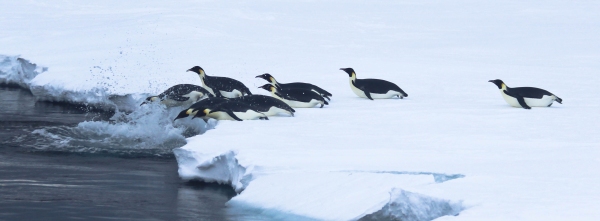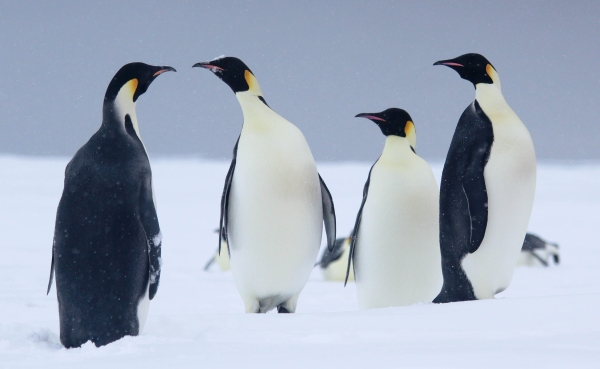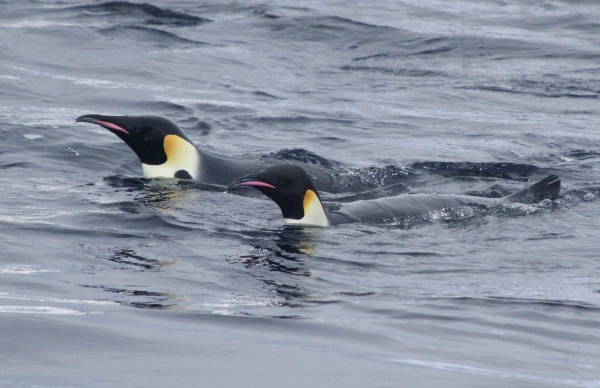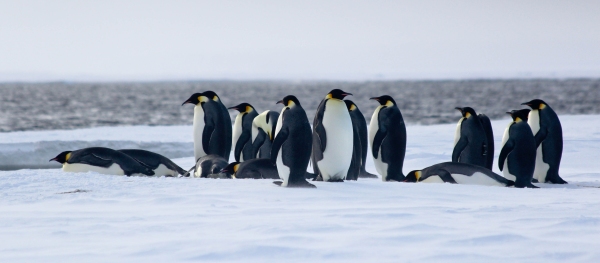An unavoidable delay in a research ship’s voyage to Antarctica resulted in some surprising and important findings about the behaviour of emperor penguins.
A newly-published paper written by NIWA marine ecologist Dr Kim Goetz and collaborators outlines the previously unknown diving and long-distance swimming abilities of emperor penguins outside the breeding season.
Emperor penguins, found only in Antarctica, are the tallest and heaviest of the penguin species, growing up to122cm high, and weighing between 22 and 45kg. As a species they gained national and international prominence when one washed up on the Kapiti Coast in 2011. It was named Happy Feet and nursed back to health by Wellington Zoo before being released back into the Southern Ocean from NIWA’s research vessel Tangaroa.
Dr Goetz’s project involved tagging 20 emperor penguins in 2013 and analysing the data on their movements transmitted via satellite. She discovered the penguins travelled between 273km and nearly 9000km and completed dives that ranged between 1 and 32.2 mins, exceeding the previous recorded dive record of 27.6 minutes.
But it was finding the penguins in the first place that was most intriguing.
“Our original goal was to tag breeding penguins at Cape Colbeck after their annual moult at the end of January. But because the voyage was delayed we didn’t get there until early March,” Dr Goetz said.
“We didn’t expect penguins to still be there and thought we would have to locate them on the pack ice which was going to be more difficult.“
To their surprise some adult emperor penguins had stayed at Cape Colbeck which were quickly tagged. When they did eventually leave, the transmitted data revealed that these penguins were not breeding birds.
“If they were breeders, their tracks would have been a lot shorter and they would have returned to the breeding ground by early June but they didn’t. They kept foraging because they had no reason to go back.”
This gave Dr Goetz and her team the opportunity to gather a lot of information about a demographic group that they hadn’t intended to study, at a time when the birds experience the most severe environmental conditions of the annual life cycle.
“It’s really cool information because it shows just how far ranging they are.”
Little is known about emperor penguin behaviour after adult birds leave the breeding colonies in mid-December to mid-January to prepare for the moult. During the moult they must remain out of the water while they replace all their feathers. As a result, the birds travel east where sea-ice is more reliable, providing a secure resting platform.
Initially the penguins, who are thought to be visual predators, travelled a short distance to the Bay of Whales, where researchers think they were feeding on Antarctic krill on the Ross Shelf. Then they headed into deeper waters.
“What we found is that there were distinct differences in the way the penguins dive depending on the depth of the water they are foraging in,” Dr Goetz said.
On the Antarctic continental shelf, the dives were shorter and shallower, while further out to sea the penguins dove deeper and for longer periods of time. “This is probably related to diet. On the shelf, the shorter dives suggest they are foraging for krill, while in the deeper ocean it is likely to be fish.”
On average, penguins dove 90.2m but did occasionally dive as deep as 450m. More than 96,000 dives were recorded and most tags remaining attached for at least six months.
Dr Goetz says further research is needed to determine whether this behaviour is normal or a result of changing sea ice conditions. In addition, future research should focus on linking prey species to emperor penguin behaviour.
“This study showed that animals go far further than we thought – this has a number of different implications for their survival. That’s why understanding their entire life cycle, especially when birds are not restrained by chick-rearing duties, is critical to predicting how emperor penguins might respond to environmental changes.”
Dr Goetz returns to the ice later this year as part of a multi-disciplinary project that includes tracking the movement of emperor penguins and Weddell seals.
Contact:
Dr Kim Goetz, NIWA marine ecologist Ph 04 382-1623
This map animation shows the movements of 20 tracked emperor penguins (red dots) in Antarctica during 2013. [Source: Dr Kim Goetz, NIWA]





